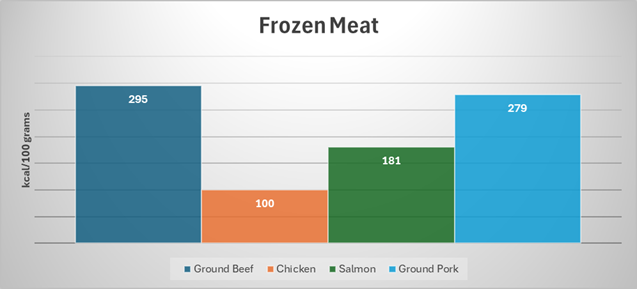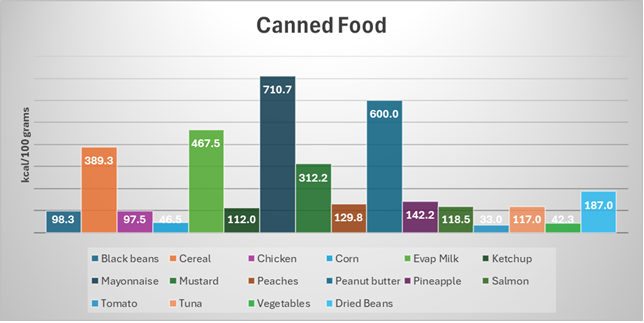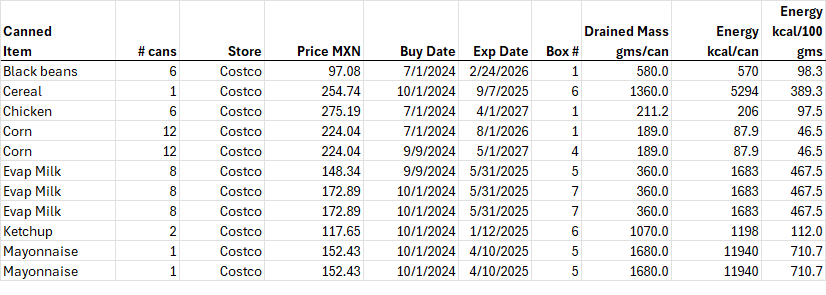The easiest way to store food is in cans and vacuum packed frozen food. Bulk stored grains, beans, etc. are the cheapest, but require special packaging to avoid insect infestation. I am not a nutritionist or cook, and my experience with food is as an eater. So the following assessment is as an engineer looking at energy densities, etc.
It is generally recommended that an active adult eat 1500 to 2000 kcal of food per day. To avoid losing body weight, 1200 kcal per day is required. Below 400 kcal per day you will starve to death. A good diet consists of meat and carbohydrates. Looking on-line for the recommended daily meat consumption is not useful. According to the vegetarians, it should be zero, while the carnivores recommend 1.5 lbs per person. However, the average US citizen ate 3/4 lbs per day of meat in 2021. This is up from 1/2 lb per day is 1961. Using the larger figure, 2 adults would eat 1.5 lbs per day or 270 lbs in 6 months. To plan for freezer storage space, ground beef, for example, has a density of .03 lbs per cubic inch, so we would need to store 9000 cubic inches or 5.2 cubic feet of meat. This is a conservative (high) estimate of the space required because vacuum sealing will increase the density of the frozen meat. Also, it is more space efficient to vacuum seal and freeze whole pieces or cubes of meat rather than ground meat. It can always be ground after thawing out. And it will last longer this way.
Our refrigerator has a freezer compartment that holds 12.8 cubic feet. So it makes sense to dedicate half of the freezer to holding vacuum sealed frozen meat and the other half to non-emergency food (pizza, ice cream, etc.) By vacuum sealing the meat before freezing it, the storage life is greatly extended. Properly sealed, most meat will last 6 to 12 months. Ground pork and sausage is said to last 2 to 4 months.
If you have a smaller freezer compartment, figure its volume then calculate how long a backup supply of vacuum packed meat will last if it fills say half this space. Meat is expensive, so it is important to rotate it as it nears its use-by date.

The above chart shows the typical energy content of meats in kcal per 100 grams. (100 grams seems to be a standard measurement of food quantity for some reason. It is just under 1/4 lb.) To convert kcal/100 gm to kcal/lb multiply by 4.54.
The caloric content of 1/2 lbs of ground beef is about 670 kcal. So if we are stocking up for a 1200 kcal per day diet, this gets us about half way. Be sure to inventory the frozen food using a spreadsheet.

Canned foods are readily available but choices are limited. The only canned meats carried by Costco, La Comer, etc. are tuna fish, chicken and salmon. They also carry canned fruits (peaches and pineapple) and vegetables (beans, corn, tomatoes, and mixed). The nice thing about canned food is that is lasts for 2 to 3 years according to the use-by dates marked on each can. With the exception of tuna, most of these canned foods are not those we would normally consume, but rotation is not a big concern in view of the long expiration times. The energy content of each can is marked on the label in grams. Also listed is the energy content in kcal. Divide the energy content in kcal by the mass in grams and multiply by 100 to get the energy content per 100 grams. The chart below shows that the most energy intensive canned foods are mayonnaise and peanut butter. Buen provecho!

So to round out a survival diet, each person should eat 1-1/2 to 2 cans of vegetables and fruit in addition to 1/2 to 3/4 lbs of meat each day. What this means is for 2 people to survive 6 months, we should stock 540 to 720 cans of food in addition to 180 to 270 lbs of frozen meat. At an average price of 34 MXN per can, that is about 20,000 MXN or US $1,000 in canned goods. The cost of the meat will be about twice this amount or US $2,000. This sounds like a lot, but all the meat and most of the canned goods would be consumed anyway, so it is not really an extra expense.
It is important to maintain an inventory of the stored food which includes where it is stored (ours is in numbered boxes), the purchase and expiration dates, etc. The best way to do this is by setting up an Excel spreadsheet so it can be sorted by expiration date, food type, box number, etc. Here is an example:

In the US, the best place to get survival food is an LDS (Morman) food storage warehouse. But these don’t exist in Mexico. However, Costco is a good alternative. They also carry vacuum sealing machines and the plastic bags.